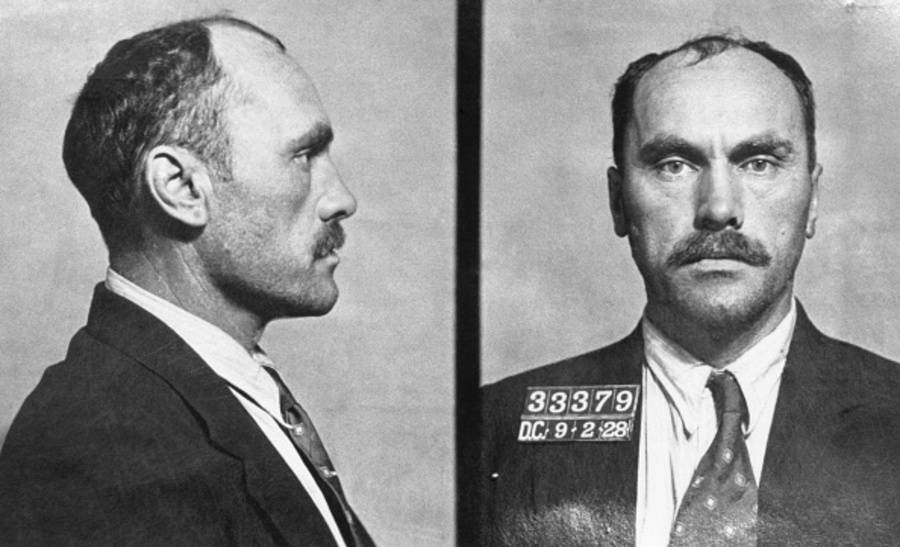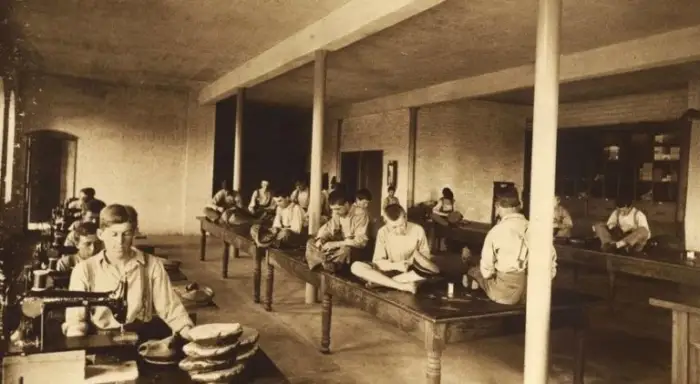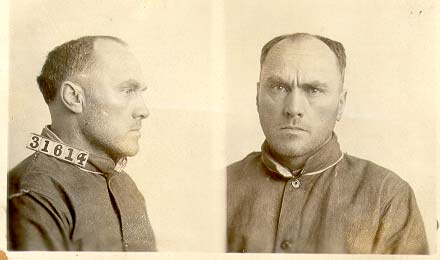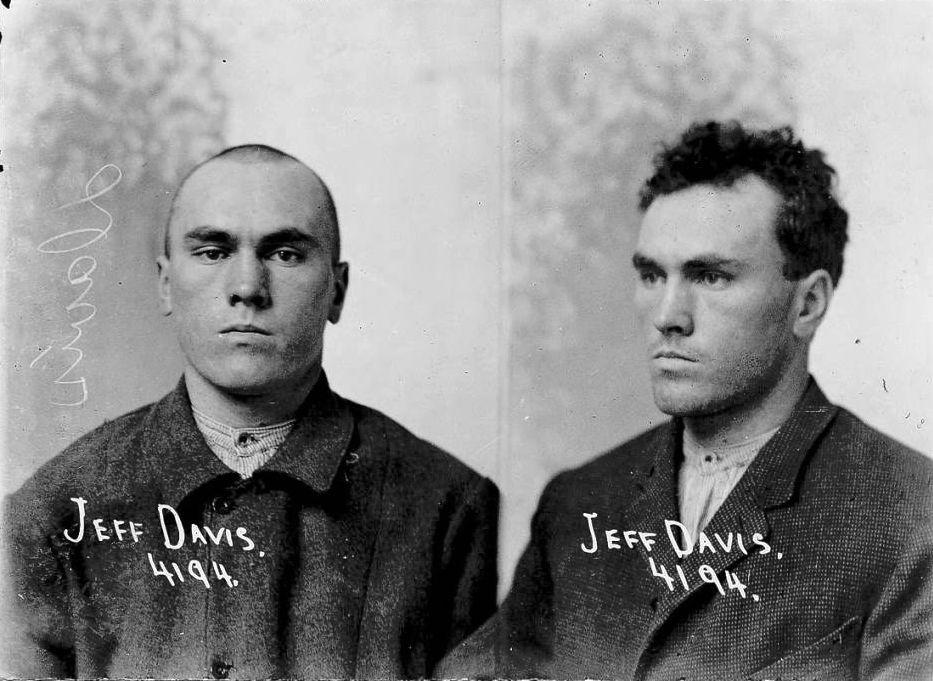Few criminals have as long a list of crimes as Carl Panzram. His criminal streak lasted for nearly four decades, spanned multiple continents, and included thousands of examples of robbery, sexual assault, and arson.
Even in his final hours, he expressed no remorse for his actions. He believed that he had been repaying the violence he experienced upon the rest of the world.
Panzram was a prime example of a psychopath who was made, not born, and a cautionary tale for the rest of the world.

Early Years: A Troubled Beginning
Carl Panzram was born on June 28, 1891, in East Grand Forks, Minnesota to East Prussian immigrants. He was one of seven total children.
As with many psychopaths, he encountered a difficult early life. Within a burgeoning industrial society that was constantly evolving, he still grew up on a rural family farm. Panzram’s parents forced him to work long hours every day on the farm to support the family.
Education was becoming more common and truancy laws were put in place. Therefore, the family experienced new tensions as Panzram and his siblings were forced to go to school.
Instead of relieving him of his farming duty, though, the family’s strict father forced them to continue the same amount of work overnight. Panzram would regularly only get a few hours of sleep a night, which had a disturbing effect on his childhood and adolescent development.
Long work hours were only the beginning of the torturous abuses the children were exposed to. Their father, Johann, would beat them, chain them up, and starve them as punishment alongside the children’s long work hours.
By the time Panzram was seven, his father abandoned the family. Eventually, three of his five brothers would also leave the family, while a fourth would drown. This left his mother, Mathilda, to handle the entire family herself which was a Herculean task under normal circumstances.
But raising Carl Panzram was not normal circumstances. By age 8 he was already demonstrating the behaviors that would make him infamous later in his life.
As an 8-year-old in 1899, Panzram was arrested for being drunk and disorderly, and once again was arrested for drunken behavior at age 11. As there was no federal drinking age dictated at the time, there were no long-term consequences for his actions, just the stress it brought upon his family.
The final straw of his criminal behavior for his mother, though, came when Panzram broke into a neighbor’s home and stole whatever he could. This included a cake, apples, and their revolver.
She sent Panzram to the Minnesota State Training School. It was advertised as a reform school for wayward children.
Panzram Burns Down his School
The school was far from the image promised though. Panzram later recounted that he was endlessly tortured and raped in what the kids called “the paint shop.” It was named this due to their experiences leaving the room “painted” in blood and bruises that they got during their unfortunate time there.
The painful experience fueled Panzram’s anger, pushing him over the edge into the first of many arson. He later burned down the building that housed the paint shop without being caught.

Like many sociopaths, Panzram then learned to lie his way through others’ expectations. By the start of 1906, he was able to convince the staff of the school that he was reformed and was paroled from the school, deemed fit to return to society.
It was a short-lived relief, however, as he found living with his family again unbearable. He was forced to reflect on his abused childhood and take care of his sick mother. He quickly fled to lead a life on the run.
He began traveling the country in train cars where he experienced further sexual assault at the hands of transient homeless men. This inspired a deep hatred for others and would later be the incident he pointed to when discussing why he committed his long list of heinous crimes.
The Military and the Spark of Hatred
The next few years were marked by more crime, incarceration, and another reform school. It was there that he assaulted a guard and met a criminal partner whom he later shared a crime spree with.
One night, when he was 16, Panzram heard a U.S. Army recruiter give a speech in a bar while he was drinking and decided to enlist. His skill at performing to expectations did not assist him there, however.
By nature and lived experience, he was insubordinate and disdainful as best towards authority. These traits do not meld with the military lifestyle.
After stealing equipment from the quartermaster’s office, he was found guilty of larceny which landed him a prison sentence at Fort Leavenworth. He was badly beaten and abused by the guards there.
He later reflected that his time there squashed the last of his humanity from him and enabled the fierce violence to come.

Criminal Escalation: A Pattern of Violence
Following his dishonorable discharge from the army, Panzram’s criminal exploits escalated. He engaged in a series of burglaries, thefts, acts of arson, and several other crimes across the United States and abroad
He was incarcerated in over a dozen high-profile prisons. Each time he was in prison his insubordination made him a target of prison guard violence.
Panzram was forced to bulk up to defend himself against guards and fellow inmates. This later allowed him to leverage his physique against his victims, in prison and beyond.
Panzram targeted vulnerable individuals, often preying on boys and young men as he traveled across the United States and Africa on different ships.
While many of his crimes were random, sometimes he committed acts of vengeance. Once, he broke into one of former President William Howard Taft’s homes and robbed him.
Taft had been Secretary of War during Panzram’s brief enlistment and had personally signed off on Panzram’s sentence. Therefore, Panzram stole from Taft to fund his transient lifestyle.
He bought a yacht, which he used to attract victims before killing them and disposing of their bodies in the Atlantic. After his ship sank, he hopped on another bound for Africa, where he spent a few years killing and raping Angolan natives before returning to the United States.
He exhibited a complete lack of empathy or remorse for his actions. He viewed his victims as worthy of the same anger and violence he had been subjected to his whole life. He left a wake of bodies and ruined lives across multiple continents.

The Capture and Imprisonment
Panzram’s criminal spree eventually caught up with him. In 1928, after being arrested for burglary, he confessed to a litany of crimes, including multiple murders.
Police were only able to affirm some of his crimes. But that was enough to earn him a 25-to-life sentence and he was sent to Fort Leavenworth Federal Penitentiary in Kansas.
As he entered the prison he warned the warden that he would kill the first person that bothered him. This warning, along with his extensive list of crimes, led the prison to place him in the laundry room to work.
The foreman of the laundry room decided to still antagonize Panzram though. Despite his many warnings to leave him alone, Panzram beat him to death with an iron bar.
This act of violence and defiance cemented Panzram’s fate. He was sentenced to death.
While on death row, a guard named Henry Phillip Lesser showed Panzram kindness for the first time in his life, and the two became friendly. With the writing materials that Lesser provided to him, Panzram wrote an autobiography and a list of his extensive crimes.
He documented that he killed over twenty people and sodomized over 1000 men, along with countless robberies and arson. On September 5, 1930, Panzram was finally executed.
As the executioner went to put the hood on him, Panzram spit in his face and told him to hurry up, insisting he could kill a dozen men in the time the executioner was taking.
After Panzram’s death, Lesser kept his autobiographical papers after his death. He spent nearly half a century trying to get them published.
He finally gave them to the Malcolm A. Love Library at San Diego State University. There, they have been used as a source for various books and documentaries about the killer.
Serial killers and psychopaths continue to capture the imagination of the general public, as people attempt to grasp what could cause human beings to commit such atrocious acts.
Panzram is a peak example of both familial and institutional failures producing a person filled with such contempt and anger that they are capable of anything. Hopefully, his story prevents future psychopaths from being created the same way.
References
Arnold, Sam H. “The Tragic Story of a Boy who was Abused and Became a Monster.” Medium, July 27, 2021. https://medium.com/crimebeat/the-tragic-story-of-a-boy-who-was-abused-and-became-a-monster-1b66b8a83ac9.
Underwood, Tammy. “The Tragic Life of Serial Killer Carl Panzram.” The Crime Wire, October 19, 2023. https://thecrimewire.com/true-crime/carlpanzram.

